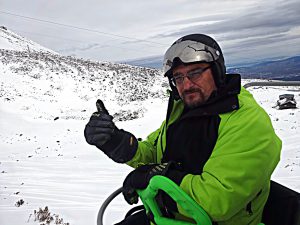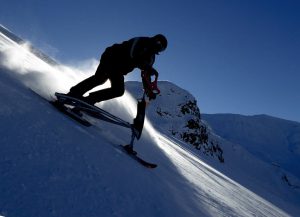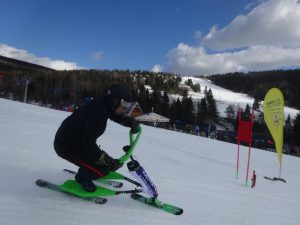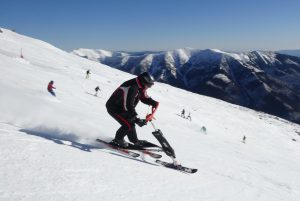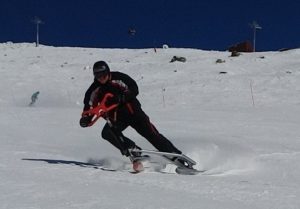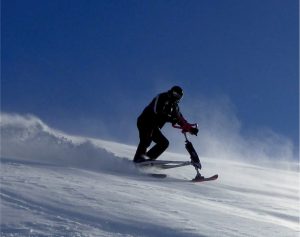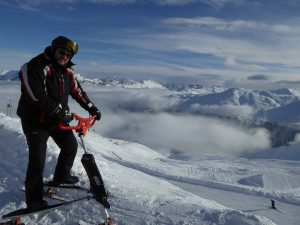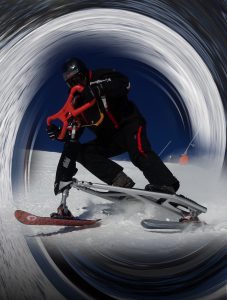HEALTH AND SAFE
Why do your knees only want you to ride a Skki Trikke?
Many people (more than 70% of users) who ride Skki Trikke are people with knee, leg or spine problems, after skiing injuries or who want to avoid skiing injuries. Having ridden Skki for many years now, we noticed a certain mechanical pattern of riding. After analyzing the forces acting on the rider, his body, the direction of the force vectors, the moments formed in this “mechanism”, we came to the conclusion (and we do not know anything about medicine, this is an engineering analysis from the side of the forces acting on the musculoskeletal apparatus in the knees) that compared to skiing while riding Skki, the knees do not take part in the ride ( compared to two-skiing). Why? Because the force goes along the femur and does not twist (there is no rotation) the knee through the tibia to the foot, the platform and to the ski.
There is no pressure on your knees while turning.
What the knees do in two skis, i.e. initiating the turn, holding the edge, we do through the steering wheel with our hands while riding Skki. The point is that in two skis, while skiing, the knee rotates in a squat, unnaturally for the knee joint. This is what the technique of two skis requires. And what it means for the knee joint, we don’t have to explain to you. And when someone already has something damaged in the knee it’s “Houston, we have a problem” ……. From thread skis, from skating, fun to rest in the snow with family, with friends. A few years ago, when we started riding the Skki Trikke, this is what we noticed and we offer our winter equipment for such people. And after many meetings, talks, tests and descriptions from various users, we came to the following conclusions:
Other health benefits of skiing on Skki Trikke.
– Skki Trikke is designed as an auxiliary equipment in the last period of rehabilitation, for skiers after knee injuries and various types of hip or knee joint complications (the most common skiing injuries).
– Skki Trikke helps to maintain the movement of the knee joints and to treat injuries such as low-grade arthrosis, high-grade arthrosis, when using different types of orthoses, after replacing the joint with an artificial joint, any injury to the knee joint
– When riding a Skki Trikke, the rear skis perform movements similar to that of a bicycle (we push the skis out similar to that of a stepper)
– The knee is loaded gently from top to bottom without lateral stresses and pushes.
– The Skki Trikke is perfect for weight loss, including knee pressure relief. The Trikke rider “works” the whole body, not just the legs. 50% work the lower body and 50% the upper body – hands, forearms, biceps, triceps, shoulder girdle. The whole body is evenly loaded, and therefore all the kinetic energy of the descent from the top to the bottom can be distributed over the whole body and not, as in a two-ski, only the legs
– Skki Trikke is the winter version of the bicycle traffic
– You are less tired on Skki Trikke than when skiing or snowboarding. There are no subsequent injuries due to overloading the musculoskeletal system or total fatigue or straining of the knee ligaments (especially during the rehabilitation period).
Why is that?
– The Skki TRIKKE has 3 skis = three points of support on the ground (snow) and perfectly distributes the weight on the arms and legs depending on the angle of the Trikker to the slope.
– The rear skis are stiff, which does not allow the legs to part, so there is no separate push on one leg or the other, including the knee joints.
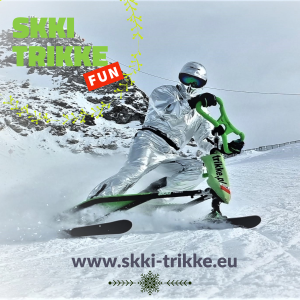
– Riding does not require the feet to be rigidly tethered to the platforms the tops are not in bindings, instead they are placed on the platform. Depending on the rider’s ankle/joint system, it is possible to adjust the positioning of the feet as much as possible for the most comfortable ride. Due to the variety of Skki Trikke riders’ physiques (feet facing inward or outward), it is possible to freely adjust the foot placement as desired. Classic skis determine one particular posture, which often leads to pain or damage to the knee joint.
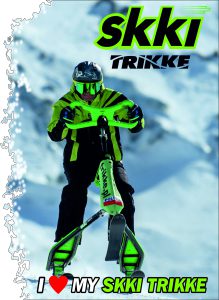
Skki Trikke riding requires ordinary winter boots. It is comfortable for the rider, does not cause additional pressure on the knees, for example, when moving from the car in the parking lot to the slope, or while standing in line at the ski lift.
– There is a lot of force on the two skis when making turns with the equipment. Through the tibia, pressure is exerted on the ligamentous apparatus of the knee and meniscus (this is especially true in modern carving skiing). All it takes is one small moment of inattention, a misaligned binding or unprepared equipment and you can suffer a serious skiing injury. On Skki Trikke this phenomenon does not occur!
– On a two-ski, the foot is braced in the shoe, so it is to the knee that all stresses are transferred and it is exposed to high torsional forces, which usually leads to damage to the anterior cruciate ligament, medial collateral ligament and medial meniscus. When riding Skki Trikke there is no phenomenon of torsional forces on the knee.
Therefor, we will not suffer any skiing injury.
– Riding a Skki Trikke is safer than skiing or snowboarding, there are no accidents and injuries to Skki Trikkers. We don’t know of anyone who has damaged their knee joints, ligaments, or meniscus riding a Skki Trikke!
– People who, before buying a Skki Trikke, had already parted with their winter trips with the family to the slopes due to knee health, skiing injuries after their first Skki Trikke ride found a new sporting life.
Other advantages
– The time to teach Skki Trikke riding ranges from 15 minutes – to 1 hour. On a two-ski, beginners succumb to skiing injuries 10 times more often than advanced skiers. Riding Skki Trikke this period is reduced to an absolute minimum.
– After a few hours of riding, you can be skiing down the red slopes and the next day down the black ones!
– Age does not stand in the way of enjoying the ride. People who ride Skki Trikke are usually 35 years old and up.
– Skki Trikke is universal for the whole family – it does not require buying different equipment for each family member separately due to, for example, age, skier’s height, boot size as it is in skiing or snowboarding (recommended from the age of 14 for everyone).
– Skki Trikke can be carried folded in the trunk of any car.
– There is no need to buy special shoes. You ride in comfortable, warm winter boots.
– Skki Trikker is higher (stands on a platform) and controls the ride better than a skier or snowboarder.
– Skki Trikker is quickly spotted on the slope and thus fewer collisions with other ski slope users are caused.
– It is not a problem to ride a Skki Trikke for several hours – without much fatigue!
– In the summer you can ride the summer version of the Trikke
This analysis is based on conversations with many users who have suffered serious injuries in the past, and many orthopedic doctors who treat skiers after injuries.
Below you can watch the ride of a person who has two knees damaged, no synovium, lubrication in the knee joints. Despite these injuries, he is freely coping with the difficult slopes in Tatrzańska Łomnica:
Why do your knees only want you to ride a Skki Trikke?
Safety
Safety and ease of learning comes from the design of all equipment.
As you know, skiing is an injury-prone sport that requires technique to master and years of learning to ride. The biggest advantage of Skki Trikke is having three skis. As you know from physics classes in school, three points define a plane. Having all three skis in contact with the snow makes for exceptional stability, confident riding and total safety. As a curiosity, the two-skier also uses the third point having a pole, which he occasionally launches to “catch” his balance. It should be added, however, that while skiing a two-skier does not have this certainty because he does not have the third point in contact with the snow all the time.
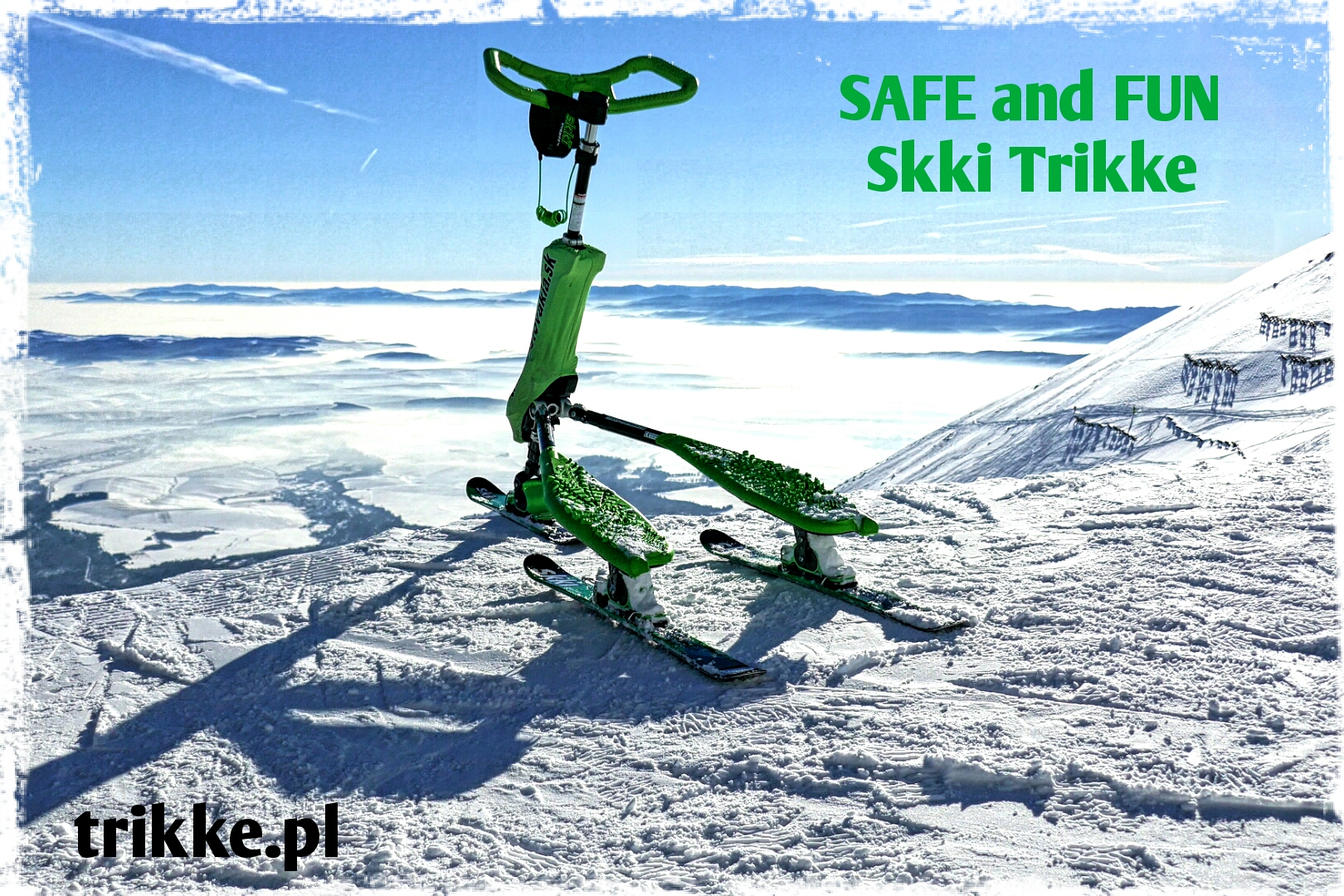
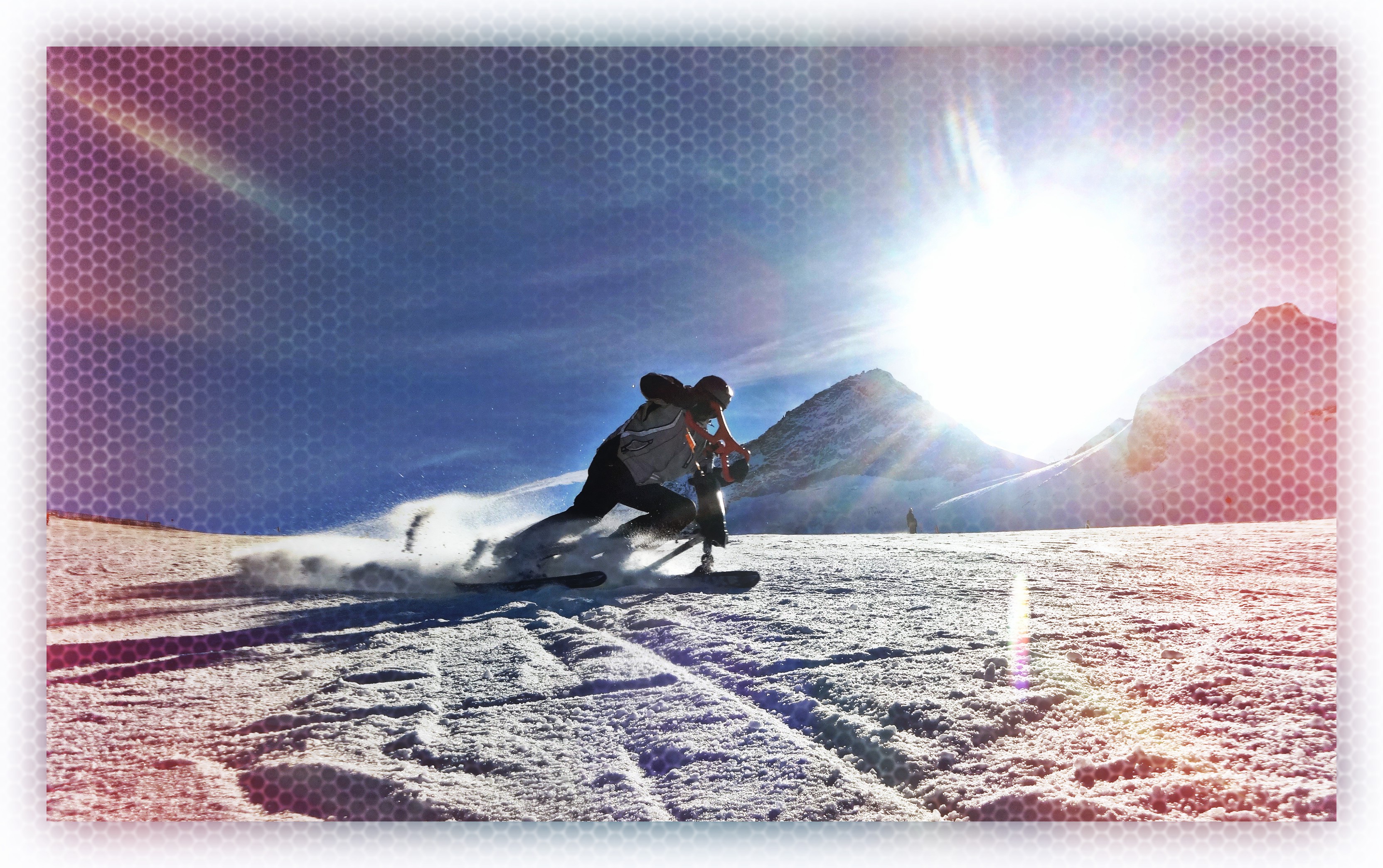
No ski bindings.
In a two-ski or snowboard, the bindings and ski/snowboard mounts are permanently responsible for edge control. On our equipment, we ride in regular winter or trekking boots. There is no unnatural position for the feet, tibias or knees. The rider freely places his feet on the platforms, rests comfortably on the handlebars ( relieving the pressure on the spine) and the edge is held, adjustable tilt of the skis in a turn by the upper body, hands.
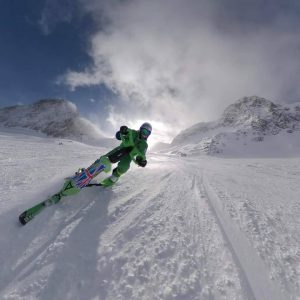
No ski bindings – you can always jump off the equipment quickly
Since we are not permanently attached to the equipment through bindings, we can jump off at any time and avoid a dangerous situation. A great advantage and freedom on the slopes and this is a great safety.
While driving, the whole body works.
Riding a Skki Trikke is not monophysical ( in two-skiing, snowboarding work ONLY legs!!), with us work 50% upper body and 50% lower body. There is no unnatural movement in the knees as is the case in two-skiing!!! There in two-skiing there is an unnatural rotation!! of the knee, a movement that is lethal to this human joint. ( hence the huge number of injuries , damage to this joint in two-skiers!!! ). When riding a Skki Trikke, the hands and the handlebars are responsible for this movement, and it is through the hands that we set and control the edges during the turn. The edge is held and controlled by the inner hand. And the outer leg, where the force goes along the bone (WITHOUT KNEE ROTATION) is responsible for pressing the outer ski against the snow. Remember that the feet are freely, naturally for a human being, positioned on the platforms. Easy, safe, not exposing any part of the body in the rider to injury. So far, in 13 years as this equipment is present on the slopes of Europe, USA, there has not been ANY PERSON WHO HAS SUFFERED A SKIING INJURY! NOT ONE!!! This is due to the design, safety of skiing on three skis, without bindings, with edge control by the upper body.
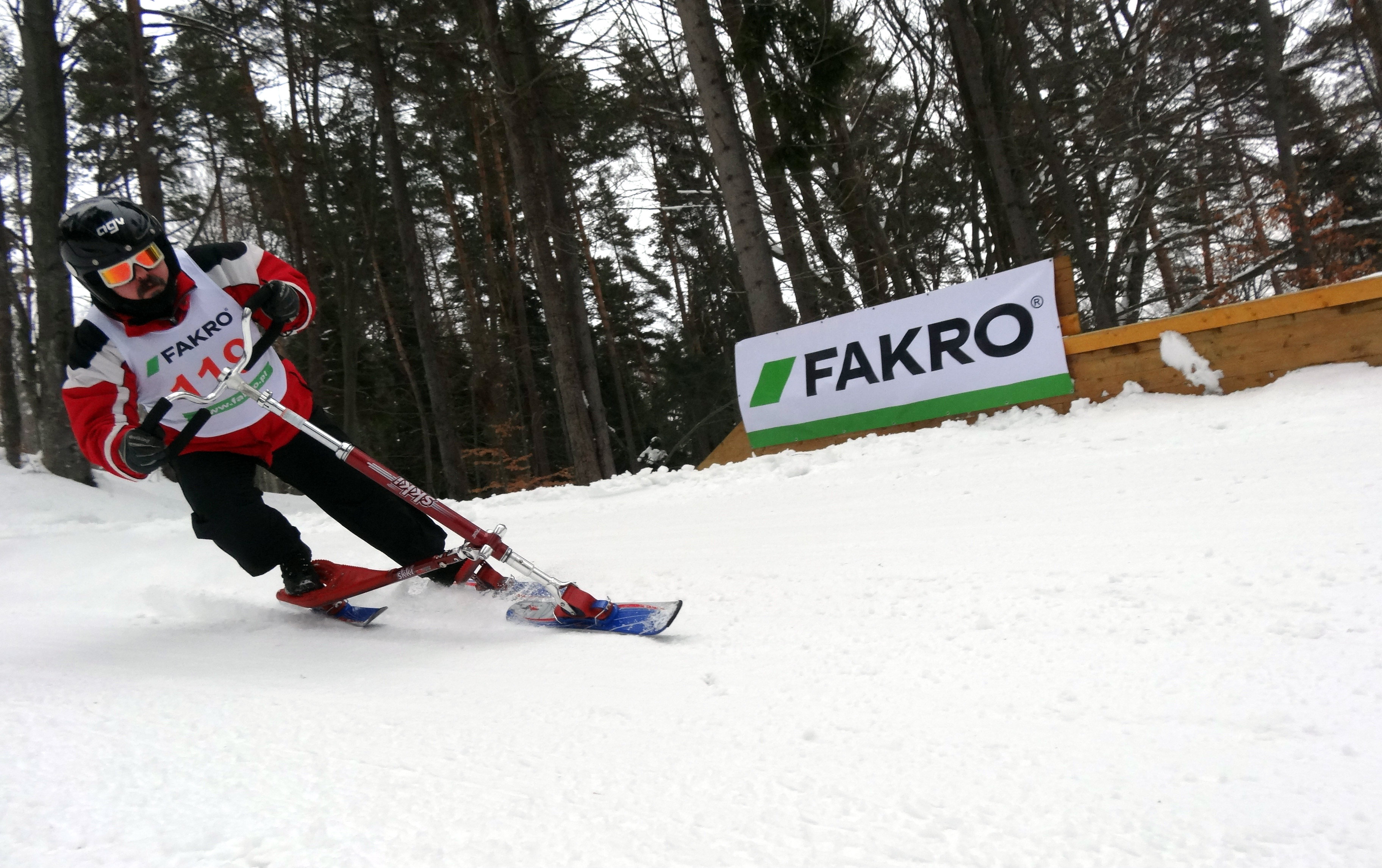
For us, riding on this equipment, an invaluable advantage is also the lack of pain in the legs, or the lack of soreness, which is further related to safety.
Well, two skis, snowboarding require the rider to control kinetic energy ( the mass of the rider plus the mass of the equipment as a function of speed in the square) with the lower parts of the body only. The two-skiers themselves say of themselves: there is force, there is technique, no force no technique and thus no control of speed or direction. We on Skki Trikke control kinetic energy while riding from top to bottom on the snow with the whole body, so the same amount of energy is distributed to twice as many muscles in the rider’s body! Therefore, we do not know the concept of leg pain, soreness. Summing up this advantage: when riding, we have no problem controlling direction or controlling speed because we have no limitations due to weakened lower parts of the body.
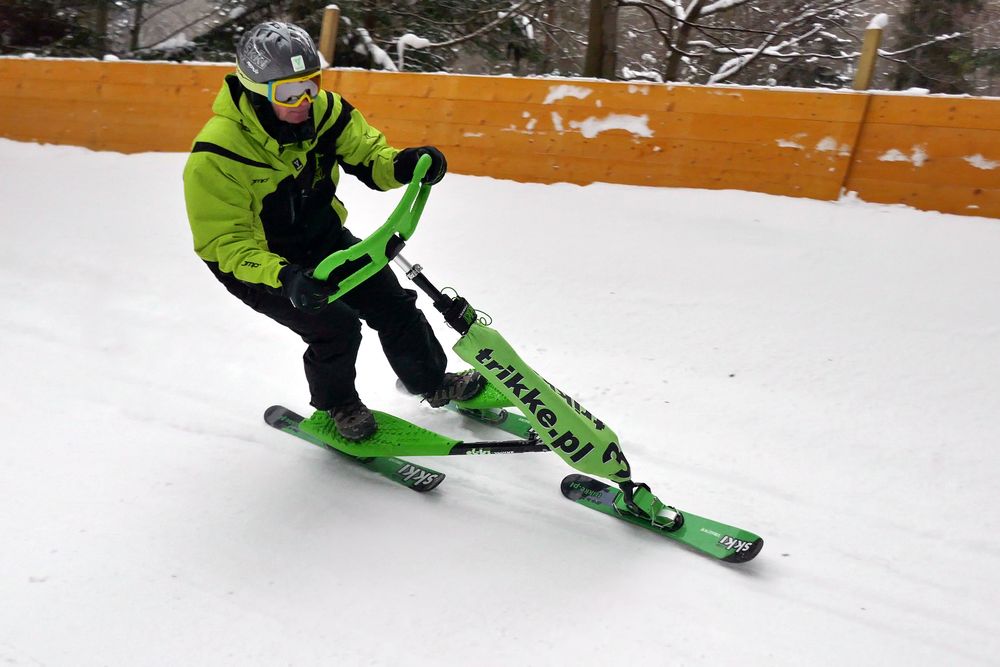
Another advantage in terms of safety, riding a Skki Trikke allows you to better assess and analyze the situation on the slope while riding.
We stand taller than two-skiers or snowboarders. We don’t look a meter, two, five in front of us as two-skiers or snowboarders do when looking for moguls or ice sheets on the slope, which for them pose a real and frequent danger. We are not interested in such places, we are not afraid of the ice, moguls because our legs do not split. We look far ahead, analyze far ahead the traffic on the ski slope, assess where snowboarders are sitting, a group of two-skiers is standing, who is studying where, where small children are skiing. Much earlier we see such things and accordingly to the situation we adjust the route of passage or our speed. An invaluable advantage!!! During the intense crowded slope exceptional safety. Therefore, with the participation of Skki Trikke NO accidents.For braking on the slope is responsible for the whole body, not just the legs.
Braking is also an important aspect of ride control. On a two-ski, snowboard, braking depends ONLY on the lower parts of the body. When riding all day, “burned, tired” muscles are certainly not so effective. We riding Skki Trikke in this element of riding use the WHOLE BODY, all muscles. When braking, we press down on the skis with our legs, but the upper body is also involved. We use our hands, forearm, biceps, triceps, shoulder girdle, spinal muscles to brake. Therefore, we brake faster, easier, better and more intensively. We don’t have such heavy loads on one muscle part as two-skiers or snowboarders, we do it more efficiently and reliably. And in extreme situations during braking, the legs with our skis have no right to move apart (frame) and braking is still the same. Two-skiers about braking can not say that. And in extreme situations during braking, the legs with our skis have no right to separate ( frame ) and braking is sure and the same. Two-skiers about their braking can not say so.
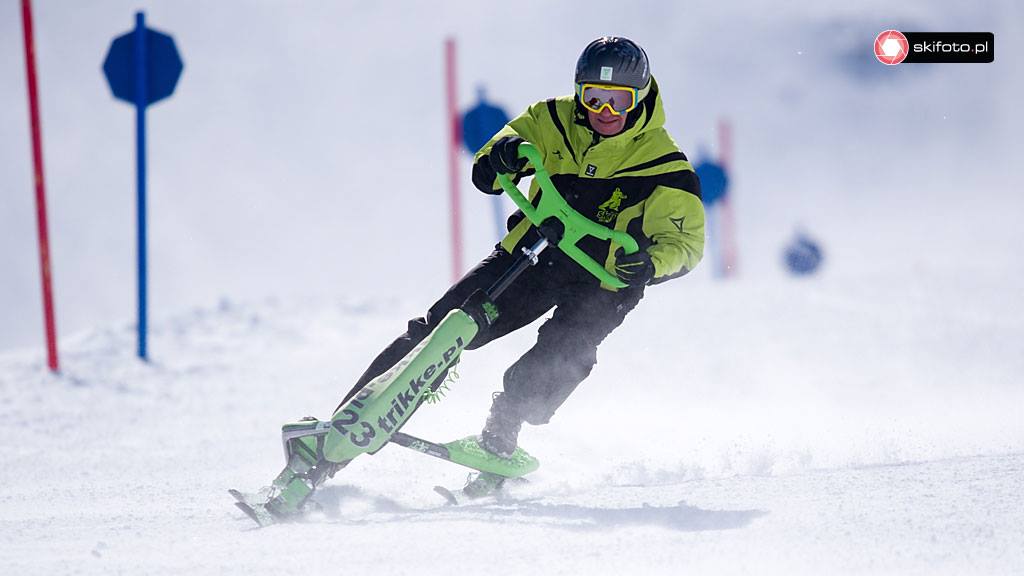
Fast and safe driving lessons – in 15 minutes you will master safe driving.
Because of the above advantages, learning to ride a Skki Trikke literally takes 15 minutes. That is, the most dangerous period on the slopes, the lack of control of direction, speed of travel has been reduced here to an absolute minimum. On skis or snowboarding, learning sometimes takes several seasons. With us, 15 minutes, after an hour of riding, the rider is 100% in control of speed and direction.
Please watch this video, where a person with a ski injury, slightly overweight, masters the ride in 15 minutes and fully controls everything that happens to his three skis while learning to ski, and does not fall over once while learning to ski. This is the crowning proof of the ease and safety of skiing.
Say goodbye to foot pain, say goodbye to uncomfortable, hard ski boots.
Please note another great and significant advantage. Due to the fact that on SKki Trikke we ride ordinary, winter, soft, comfortable shoes with rubber bottoms then with us there is no possibility of slipping on the stairs, the entrance to the bathroom or the restaurant on the slope. In the history of skiing accidents there are injuries, fractures in bicyclists wearing hard plastic boots when they slipped on stairs or a slippery wet floor. The unnatural flexing of the tibia and leg, plus a plastic, hard, slippery ski boot, plus some water, ice gives a mixture that at any time can cause the leg to slip and fall. Broken arm, collarbone, leg ready. Skki Trikke riders absolutely do not know this!!!
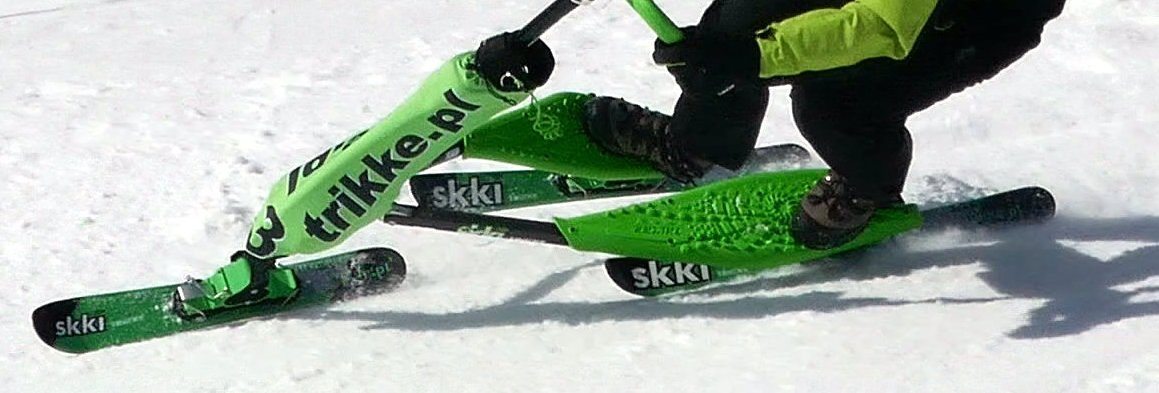
Skki Trikke – skis with space bindings.
Due to the advantages and safety, Skki Trikke can be classified that they are skis with space bindings ( a frame that keeps ALWAYS skis in contact with the snow and gives 100% control of the ride to the rider) .
Skki Trikke can be successfully ridden by people after skiing injuries, people with disabilities!
Many people with certain fitness limitations use our equipment. People after skiing injuries ( torn ligaments in knees, damaged meniscus, ligament reconstructions, damaged hips, ankle joints, back problems). This is the only equipment that ensures their safety and ease on the slopes. Imagine what their double-skiing or snowboarding would be like if they showed up on the slopes with such injuries? A certain lack of directional and speed control and, in extreme cases, a certain subsequent injury or accident after losing control of the ride. Skki Trikke has no such limitations and hundreds of people have returned to winter sports activities thanks to our equipment.
In addition, there are dozens of people with disabilities ( problems with joints, knees, hips, with feet, spine) who ride freely and ensure their safety and that of others on the slopes.
Fun
Rivalry, competition, Skki Extreem Cross
For many years we have been organizing many events ( Slovakia Cup), competitions or our International Polish Championships FAKRO Cup. Every year we have dozens of riders at the starting line, our fans who have been going to our competitions for many years.
Our crowning discipline is the Trikke Skki Extreem Cross held at SkkiTor in Muszyna. It is one of the competitions held at the Polish Championships. We always warmly invite everyone to this our already cult event. Regardless of age, skills you will always have a lot of fun sports competition, adrenaline and power of positive energy.
Trikke SKKI EXTREEM Cross
Fakro Cup 2018

